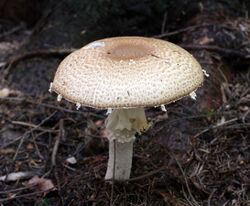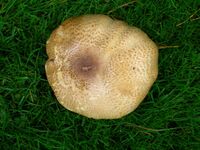Biology:Agaricus augustus
| Agaricus augustus | |
|---|---|

| |
| Scientific classification | |
| Domain: | Eukaryota |
| Kingdom: | Fungi |
| Division: | Basidiomycota |
| Class: | Agaricomycetes |
| Order: | Agaricales |
| Family: | Agaricaceae |
| Genus: | Agaricus |
| Species: | A. augustus
|
| Binomial name | |
| Agaricus augustus | |
| Synonyms | |
|
Psalliota augusta (Fr.) Quél. | |
| Agaricus augustus | |
|---|---|
| Mycological characteristics | |
| gills on hymenium | |
| cap is convex | |
| hymenium is free | |
| stipe has a ring | |
| spore print is brown | |
| ecology is saprotrophic | |
| edibility: choice | |
Agaricus augustus, known commonly as the prince, is a basidiomycete fungus of the genus Agaricus.
Taxonomy
According to Heinemann's (1978) popular division of Agaricus, A. augustus belongs to section Arvenses.[2] The system proposed by Wasser (2002) classifies A. augustus within subgenus Flavoagaricus, section Majores, subsection Flavescentes.[3] Moreover, there have been attempts to recognise distinct varieties, namely A. augustus var. augustus Fr., and A. augustus var. perrarus (Schulzer) Bon & Cappelli. The specific epithet augustus is a Latin adjective meaning noble.
Description
The fruiting bodies of Agaricus augustus are large and distinctive agarics. The cap shape is hemispherical during the so-called button stage, and then expands, becoming convex and finally flat, with a diameter from 8–30 cm (3–12 in).[4] The cap cuticle is dry, and densely covered with concentrically arranged, brown-coloured scales on a white to yellow background.
The flesh is thick, firm and white and may discolour yellow when bruised. The gills are crowded and pallid at first, and turn pink then dark brown with maturity. The gills are not attached to the stem—they are free. Immature specimens bear a delicate white partial veil with darker-coloured warts, extending from the stem to the cap periphery.
The stem is clavate and 7–30 cm (3–12 in) tall, and 2–6 cm (3⁄4–2 3⁄8 in) thick.[4] In mature specimens, the partial veil is torn and left behind as a pendulous ring adorning the stem. Above the ring, the stem is white to yellow and smooth. Below, it is covered with numerous small scales.[5] Its flesh is thick, white and sometimes has a narrow central hollow. The stem base extends deeply into the substrate.[5]
The mushroom's odour is strong and sweet, similar to almond extract, marzipan or maraschino cherry, due to the presence of benzaldehyde and benzyl alcohol.[6][7] Its taste has been described as not distinctive.
Under a microscope, the ellipsoid-shaped spores are seen characteristically large at 7–10 by 4.5–6.5 μm. The basidia are 4-spored. The spore mass is coloured chocolate-brown.[2][8]
A species initially reported from North America, A. subrufescens closely resembles A. augustus in appearance. However, A. subrufescens produces smaller spores, sized 6–7.5 by 4–5 µm.
Identification
Agaricus augustus shows a red positive Schaeffer's test reaction. The cap cuticle turns yellow when a 10% potassium hydroxide solution is applied.[2]
Toxic lookalikes include Amanitas which stain yellow when bruised or emit bad odor.[9] Another similar-looking toxic species is Agaricus moelleri.[4]
Habitat
Agaricus augustus has a widespread distribution, occurring throughout Europe, North America, North Africa and Asia. This mushroom is found in deciduous and coniferous woods and in gardens and by roadside verges. The fungus is saprotrophic and terrestrial—it acquires nutrients from decaying dead organic matter and its fruiting bodies occur on humus-rich soil. The species seems adapted to thriving near human activity, for it also emerges from disturbed ground.[10] In Europe, A. augustus fruits in late summer and autumn.[8]
Edibility
This mushroom is a choice edible,[4][11] and is collected widely for consumption in Eurasia, the United States, Canada and some parts of Mexico. A. augustus has been implicated in specifically bioaccumulating the metal cadmium, with a quantity of 2.44 mg per kilogram of fresh weight as recorded in one Swiss study.[12] The same phenomenon is true for other edible species of Agaricus, namely A. arvensis, A. macrosporus and A. silvicola, though quantities may vary greatly depending on species, which part of the fruiting body is analysed, and the level of contamination of the substrate. Specimens collected near metal smelters and urban areas have a higher cadmium content. The hymenium contains the highest concentration of metal, followed by the rest of the cap, while the lower part of the stem contains the least.[13]
See also
References
- ↑ "Agaricus augustus taxon record details at Index Fungorum". Index Fungorum. http://www.indexfungorum.org/Names/SynSpecies.asp?RecordID=205947.
- ↑ 2.0 2.1 2.2 Noordeloos M. E. (2001). Volume 5 of Flora Agaricina Neerlandica: Critical Monographs on Families of Agarics and Boleti Occurring in the Netherlands. CRC Press. pp. 44–45. ISBN 90-5410-495-3. https://books.google.com/books?id=YaBiXhgkfccC&q=bibliogroup:%22Flora+Agaricina+Neerlandica:+Critical+Monographs+on+Families+of+Agarics+and+Boleti+Occurring+in+the+Netherlands%22. Retrieved 2010-01-13.
- ↑ Lacheva, Maria (January 2006). "Genus Agaricus L. in Bulgaria–Taxonomy, Ecology, Chorology and Economic Importance (in Bulgarian)". Agrarian University - Plovdiv: 18–19. http://www.botanica.hit.bg/doc/AgaricusPhDthesis.pdf.[yes|permanent dead link|dead link}}]
- ↑ 4.0 4.1 4.2 4.3 Davis, R. Michael; Sommer, Robert; Menge, John A. (2012). Field Guide to Mushrooms of Western North America. Berkeley: University of California Press. pp. 221–222. ISBN 978-0-520-95360-4. OCLC 797915861. https://www.worldcat.org/oclc/797915861.
- ↑ 5.0 5.1 Trudell, Steve; Ammirati, Joe (2009). Mushrooms of the Pacific Northwest. Timber Press Field Guides. Portland, OR: Timber Press. pp. 189. ISBN 978-0-88192-935-5. https://books.google.com/books?id=WevHvt6Tr8kC.
- ↑ Wood W. F.; Watson R. L.; Largent D. L. (1990). "The Odor of Agaricus augustus". Mycologia 82: 276-278. doi:10.2307/3759861.
- ↑ The Mycological Society of America (2002). "The anise-like odor of Clitocybe odora, Lentinellus cochleatus and Agaricus essettei". Mycologia 94 (3): 373–376. doi:10.2307/3761770. PMID 21156507. http://www.mycologia.org/cgi/content/full/94/3/373.
- ↑ 8.0 8.1 Michael Jordan (1995). The Encyclopedia of Fungi of Britain and Europe. David & Charles. p. 221. ISBN 0-7153-0129-2.
- ↑ Meuninck, Jim (2017). Foraging Mushrooms Oregon: Finding, Identifying, and Preparing Edible Wild Mushrooms. Falcon Guides. p. 109. ISBN 978-1-4930-2669-2.
- ↑ Arora D. (1986). Mushrooms Demystified: a Comprehensive Guide to the Fleshy Fungi. Berkeley, Calif: Ten Speed Press. p. 45. ISBN 0-89815-169-4. https://archive.org/details/mushroomsdemysti00aror_0/page/45. Google Books
- ↑ Boa ER. (2006) (in fr). "Champignons Comestibles Sauvages" [Edible Wild Mushrooms]. Food and Agriculture Organization of the United Nations. p. 141. ISBN 92-5-205157-0.
- ↑ Neukom P. (2005). "Métaux toxiques dans les champignons comestibles. Danger pour la santé des consommateurs?" (in fr). Bulletin Suisse de Mycologie 15 (4): 170–171. ISSN 0373-2959.
- ↑ Kalač P.; Svoboda L.; Havlíčková B. (2004). "Contents of cadmium and mercury in edible mushrooms". Journal of Applied Biomedicine 2: 15–20. doi:10.32725/jab.2004.002. ISSN 1214-0287.
External links
- Tom Volk's fungus of the month - Agaricus augustus
- Electronic Atlas of the Plants of British Columbia - Agaricus augustus
- Mykoweb - Agaricus augustus
Wikidata ☰ Q267538 entry
 |



